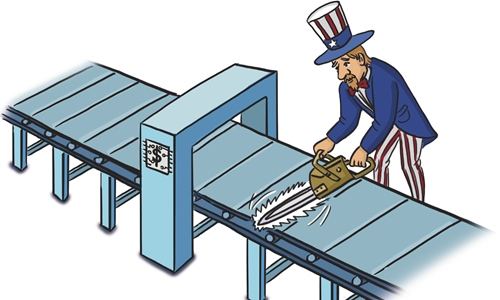COMMENTS / EXPERT ASSESSMENT
Countries could face US' 'semiconductor nationalism'

Illustration: Liu Xidan/GT
The US is re-constructing the industrial chain of global semiconductors in a bid to fully control it from design to assembly and testing, which has been dubbed as "semiconductor nationalism."
Against the backdrop of intensifying tech protectionism, countries and regions, including China, need to get ready to deal with the enhancing anti-globalization and switch development strategies from integration to independent development.
Countries such as the US and Japan, which are at the upstream of the global semiconductor industry chain, are showing increasingly stronger intention of anti-globalization now. The US government is in talks with chip manufacturing giants Intel and Taiwan-based TSMC, seeking to set up new chip factories in the US to realize self-sufficiency, according to the Wall Street Journal.
If the US' semiconductor nationalism is being embodied in measures, the global chip industrial chain will be hindered, among which some Taiwan-based companies like TSMC will take the first blow.
TSMC has successfully seized the opportunity of the previous round of the division of labor and grew into a leader in the global semiconductor manufacturing industry with over 50 percent of the market share. During the division of the labor in the industry, design and manufacturing gradually split up, which brought in more communication costs and technology reservation between design and manufacturing companies, but was also beneficial for largely reducing production costs.
The shift of semiconductor manufacturing to East Asian countries and regions was mainly the result of intense competition among American technology companies and division of labor of the industry. Earlier before the division of labor, chip companies were mostly operating independently, which had a better connection between design and manufacturing, but also derived high costs.
However, although the US had experienced a large-scale deindustrialization in the second half of the 20th century, it still maintains advantages in the semiconductor sector with companies such as Intel, which could complete the whole process of the chip design to producing. The country has held on to cutting-edge semiconductor manufacturing techniques over the past decade.
The US' aggressive promotion of anti-globalization will force countries and regions to pick sides. For instance, it may restrict the Netherlands-based ASML to sell EUV lithography machines or block Japan to sell raw materials to Chinese manufacturers. All such measures will disrupt the global industrial chain, and trigger technology protectionism by other players, such as Japan.
With a more monopolistic position, the US will force the industry into a "technology diversion" era, and the door will be closed for economic entities in the downstream or outside of the industrial chain.
China's semiconductor sector has faced a crackdown by the US government since the trade war and companies in business with Western firms are seeing rising risks of cutting off technology cooperation.
Under such circumstances, China should switch its strategy from integration with the international mainstream to independently develop own core technologies. While on the other hand, it should step up efforts to promote cooperation among different parts of its semiconductor industry and try to independently develop instead of pursuing advancement of a single technology.
Although the cutting-edge techniques always draw a lot of attention, most industries are still using previous techniques and maintain a large market. Chinese firms could still develop on previous techniques and cultivate advanced technologies. Independent development will be slower, but will be more solid and controllable amid any hostile environment.
The author is an observer of the technological economy. bizopinion@globaltimes.com.cn
